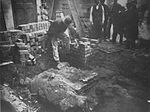The Colmore Building
Buildings and structures in Birmingham, West Midlands

The Colmore Building, formerly known as Colmore Plaza, is a 14-storey office building in the Colmore Business District area of Birmingham City Centre.
Excerpt from the Wikipedia article The Colmore Building (License: CC BY-SA 3.0, Authors, Images).The Colmore Building
Colmore Circus Queensway, Birmingham Digbeth
Geographical coordinates (GPS) Address External links Nearby Places Show on map
Geographical coordinates (GPS)
| Latitude | Longitude |
|---|---|
| N 52.483555555556 ° | E -1.8957222222222 ° |
Address
Colmore Plaza
Colmore Circus Queensway 20
B4 6AT Birmingham, Digbeth
England, United Kingdom
Open on Google Maps









